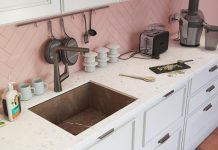
Are you in the middle of a debate about the style of the new bathtub in your just renovated bathroom? Which way do you go? A back-to-wall design or a freestanding one? The choice you make will impact the overall look of the bathroom and play a significant role in the layout. Both options bring unique characteristics to the table, influencing not only the aesthetics of the space but also its functionality and overall ambiance.
Back-to-Wall Tubs: Seamless Integration

Back-to-wall tubs, also known as alcove, are designed to be installed against one or more walls in a bathroom. This configuration offers a seamless integration with the surrounding space, providing a clean and cohesive look. The space-savvy back to wall bathtub makes for an excellent choice for smaller bathrooms or those with limited floor space.
What Are the Benefits of Back to Wall Tub?
Space Efficiency and Practicality
One of the standout features of a tub like this is its ability to optimise space. By utilising the existing walls in a small bathroom, this type of tub creates a compact and efficient bathing area without compromising on functionality. This is particularly beneficial in urban living spaces or homes where square footage is at a premium. The ability to incorporate a shower over the tub in a back-to-wall configuration further enhances the practicality of this design, making it a versatile choice for those who prioritise multifunctional spaces.
Installation and Cost Considerations
Installing a back to wall bathtub is generally more straightforward than installing a freestanding tub. The connection to existing plumbing is simplified, and the construction of an enclosure around the tub is often unnecessary. This ease of installation can translate into cost savings, making this style of tubs an appealing option for budget-conscious homeowners.
Design Flexibility
While back to wall bathtubs are often associated with practicality, they also offer a considerable degree of design flexibility. Manufacturers produce a wide range of styles, materials, and sizes, allowing homeowners to choose a design that complements their aesthetic preferences. Whether you prefer a sleek and modern or a more traditional look, there is one to suit every taste.
Freestanding Tubs: Elegance and Statement

On the opposite end of the spectrum, freestanding tubs are a symbol of luxury and elegance in bathroom design. These standalone fixtures command attention and serve as focal points, transforming the bathroom into a spa-like retreat. The allure of freestanding tubs lies not only in their aesthetic appeal but also in the sense of indulgence and relaxation they evoke.
Aesthetic Appeal and Versatility
Freestanding tubs are available in an array of shapes, materials, and styles, allowing homeowners to express their individuality and create a personalised sanctuary. The variety of designs, from classic clawfoot tubs to modern, sculptural forms, ensures that there is a freestanding tub for every taste and bathroom theme. The versatility makes them suitable for both contemporary and traditional spaces, adding a touch of timeless sophistication.
Visual Impact and Focal Point
One of the most compelling arguments for choosing this type of tub is its ability to become the focal point of the bathroom. Placed away from the walls, a freestanding tub draws the eye and creates a sense of openness and luxury. The visual impact of a well-chosen piece can elevate the entire bathroom design, turning it into a space that exudes style and opulence.
Spa-Like Experience
Beyond aesthetics, freestanding tubs offer a unique bathing experience. Their standalone nature allows for placement in various locations within the bathroom, including near windows or as a centrepiece in the room. This positioning enhances the overall atmosphere, providing a spa-like ambiance that encourages relaxation and rejuvenation.
Considerations and Challenges
While freestanding tubs offer undeniable allure, there are practical considerations and challenges to be aware of. The installation process can be more complex, often requiring additional plumbing work that can potentially impact the overall cost. Moreover, the open design of freestanding tubs may lead to splashes, necessitating careful planning to prevent water damage to surrounding surfaces.
Choosing Between the Two
The decision between these two styles ultimately depends on individual preferences, the available space, and the desired aesthetic for the bathroom. Here are some factors to consider:
Space Constraints: If space is limited, a back-to-wall tub may be the more practical choice, maximising the available square footage. Freestanding tubs, with their open design, require more room and are better suited to larger bathrooms.
Aesthetic Preferences: Consider the overall design theme of your bathroom. If you’re aiming for a sleek, integrated look, a back-to-wall tub may be the better fit. On the other hand, if you want to make a bold statement and create a luxurious retreat, a freestanding tub might be the ideal choice.
Budget and Installation: Evaluate your budget and the complexity of the installation process. Back-to-wall tubs are generally more cost-effective and easier to install, making them a pragmatic option for those with budget constraints or tight timelines.
Bathing Experience: Think about the type of bathing experience you desire. If you prioritise a spa-like atmosphere and visual impact, a freestanding tub may be worth the investment. If functionality and practicality are paramount, a back-to-wall tub is a sensible choice.
Maintenance: Consider the ease of cleaning and maintenance. Freestanding tubs, with their exposed surfaces, may require more attention to prevent water splashes and maintain a pristine appearance. Back-to-wall tubs, enclosed on three sides, can be easier to maintain in this regard.
Bottom Line
Each option brings its own set of advantages and considerations, catering to different tastes and practical needs. The key is to carefully weigh the factors that matter most to you, considering the available space, budget, design preferences, and desired bathing experience. Whether you opt for the seamless integration of an alcove tub or the statement-making elegance of a freestanding tub, the ultimate goal is to create a bathroom that reflects your style and provides a sanctuary for relaxation and rejuvenation.















